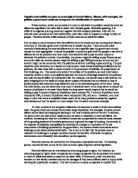The third difference is between progressive, regressive and proportional taxes; income tax is an example of progressive tax because people on higher earnings pay a higher tax rate as opposed to people on a lower wage. The basic rate of income tax was cut between 1979 and 1997 from 33% to 23% and the higher rate dropped from 80% to 40% meanwhile a lower band was introduced at 20 % on the first £2000 of taxable income, rising to £4,100 in 1997. (Haralombos & Holborne 2002)
Recently statistics show that households in the UK currently approximately 35% of income are tax deductible in the poorest and richest households; this consequently effects the poor more than the rich. If Income tax is increased this may effect an individuals desire to work. To increase taxes, it has been argued, may cause a disincentive to work and may deter individuals from working harder in two ways. (Le Grand, Propper & Robinson). Firstly it will decrease the wage an employee receives from working an extra hour and secondly an employee may be inclined to decrease the amount of hours worked, and substitute these hours in leisure activities as opposed to hours in paid employment.
2
Another division is that of general and earmarked tax (or hypothecated tax) general taxes are taxes that the government uses at its own discretion and can be used for whatever purpose they decide, earmarked taxes are used to pay for a specific value such as National Insurance Contributions.
National Insurance Contributions is tax paid in relation to a wage by an employee and is also paid by an employer. This is the most vital form of finance for the social services in many countries and has been used to fund social security and also health and social care. (Le Grand, Propper & Robinson). National Insurance paid by employees is said to be close to the amount of household income before tax paid by people in the lower income bracket. Households with the top income in the UK pay nearly 25% of their income in tax, in effect to try to reduce the inequality of gross incomes. While households in the bottom lower income bracket pay 7.5 % of their gross income but 8.2 % when including National Insurance, those in the top wage bracket pay 43% and 41 % respectively.
Most public services today carry a ‘fee’ such as for use of swimming pools and leisure services, more often it is a ‘charge’ that is used, this may be minimal and is basically a small amount or donation a fraction of the total cost. Charges are more common now than in previous years with for example the introduction of dental and optical charges. The main problems with these charges are that those on lower incomes may be unable to afford or avail of them, although local and central government offer rebate schemes for these individuals such as free prescriptions for children, pensioners and benefit recipients. The disadvantages of the rebate scheme are that it has a slow uptake and that many people on low incomes are opposed to another means test. Another is that these rebates only bring in a small percentage of charges such as 3% for NHS and 9% for personal social services. In March 2002 Tony Blair told the House of Commons that the only way to fund the ailing National Health Service was to increase taxes. New Labour has apparently reverted to its old ways of the tax and spend party.
Recent UK governments have not been very successful in their attempts to tax wealth. The main tax on wealth before 1974 was called Estate Duty, which was paid on the estate if someone died. This proved very easy to avoid as tax could be transferred before death. After 1974 the Labour government replaced this with capital gains tax which was further abolished by the conservatives who replaced this with inheritance tax. This meant that the longer someone lived after passing on their assets to someone else, the less tax was payable, reducing the tax burden dramatically on the wealthy. (Harolambos and Holborn 2002)
Many of the key problems facing the government financing the statutory social services are related to the redistribution of income from the higher to lower income groups. The government does not possess finance of its own; it exists by collecting taxes. If the government overspends in financing statutory bodies as in 1992 they will be forced to raise taxes. Raising taxes is said to cause a disincentive to work. The new Labour government had pledged a distributive tax system and promised not to increase taxes (Harolambos &Holborn), but I feel that I must point out that the present Labour Government has
3
gone back on its word and is putting up tax, The Chancellor Gordon Brown described it as 'a duty' and “More than that, taxes will rise not out of compulsion, not because they've dashed the economy on the rocks”. (www.observer). Taxes rise in the belief that this will produce increases in public goods which Labour had promised but has not delivered. Tony Blair and Gordon Brown had promised that we could enjoy better public services and lower levels of tax, now they contradict themselves with the fact that serious spending requires serious tax, even if they still prefer to call it money for modernisation. In the most recent Budget we can see that the amount the Chancellor is proposing to repay in debt declines sharply in 2005, which, consequently happens to be the most likely year of the next election. It would not be surprising if there were cuts in taxes just before the Government attempts to get re-elected for a third term.
4
Bibliography
Le Grand, J.Propper, C.,Robinson, R. (1992) The Economics of Social Problems. (Third Edition) London, Macmillan.
Harolambos, M. Holborne, M. (2002) Sociology Themes and Perspectives (Fifth Edition) London, Harper Collins.
Rawnsley, A New Labour Grows Up (2002) The Observer
http//: /story/0,6903,687946,00.html







